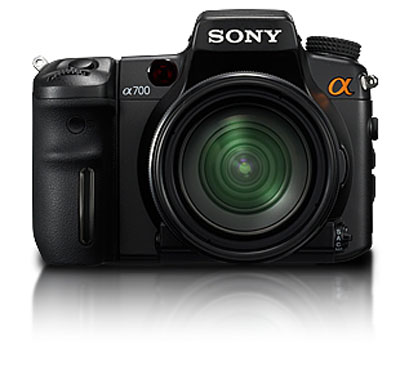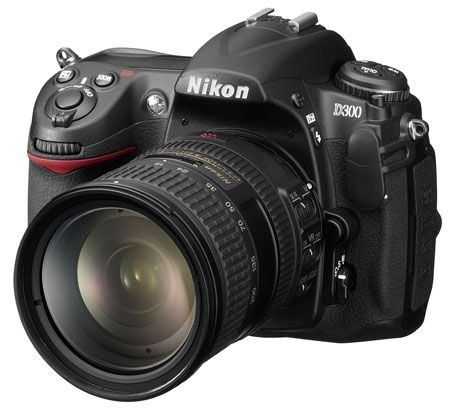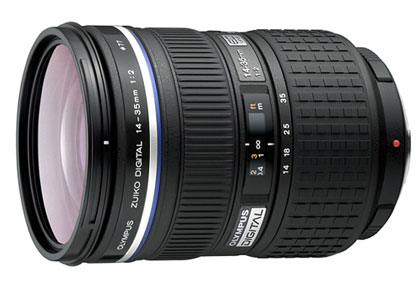Digital Camera Buyers' Guide - Year of the SLR
by Wesley Fink on November 23, 2007 6:00 AM EST- Posted in
- Digital Camera
Prosumer SLRs
It seems everyone is introducing new prosumer models. Understanding what's hot in this market of hard-to-please photography buffs will help you know what to look for in an entry-level camera. If you're in the market for one of these advanced amateur DSLRs, you may want to pay closer attention.

Sony started this prosumer round, just as they started the 10 megapixel (MP) round last year. The new top-of-the-line Sony is now their $1400 A700. Those who doubted that Sony was in the digital SLR market to win were greeted with a slick, stylish, and very fast 12.2MP DSLR with image stabilization, auto dust cleaning, a 3" hi-res LCD, 5.0FPS shooting, and new Sony brand lenses. Conspicuously absent is Live View, a feature pioneered by Olympus on DSLR cameras that allows the user to see through the lens on the LCD. This is standard fare on a point-and-shoot, but difficult to do with the "through-the-lens" optical viewing that is a feature of SLR technology.

Because they are so huge and influential in the photo market, Canon prosumer models receive lots of scrutiny. The new Canon model is the 40D, which continues the 20D/30D models that have defined the Canon prosumer DSLR. The 30D is 8MP and the 40D raises that to 10MP. Many expected an even higher-resolution 40D, but instead the 40D features the same 10MP resolution seen in the entry-level Canon XTi for the past year. New for the $1300 40D is much faster auto-focus, a 3" LCD replacing the 2.5", dust cleaning on startup, dust sealing, and Live View - a first for Canon. There are many other improvements, but they refine existing features of the Canon line.

Nikon announced - but has not shipped - the new D300, which is an update to the D200. The D200 got lost in the wake of the entry-level D80 last year. Nikon uses Sony sensors with their own electronics, and it appears the new D300 uses the same Sony 12.2MP CMOS sensor with on-sensor noise reduction found in the Sony A700. The D300 will launch at a street price of about $1800. The D300 also features a 3" hi-res LCD, very fast autofocus, Nikon's first auto sensor-cleaning system, 6FPS shooting, dust/splash sealing, and Live View.

Olympus has come to life recently, just when many had all but given up on them. Always the innovator, Olympus pioneered auto dust cleaning and Live View on digital SLR cameras based on their "digital-only" 4/3 standard. However, the Olympus 4/3 system was getting very long in the tooth, with a 5.5MP pro model E-1 introduced in 2003. Olympus has just started shipping their new E-3 flagship, which thoroughly updates the Olympus system.
Olympus says the E-3 is their pro model, and it features dust and splash sealing for both the E-3 body and pro lenses. The E-3 also introduces the first new AF module for Olympus in many years. The new AF, which was long overdue, features 11 cross-type sensors, each on two planes, for a total of 44 segments. According to Olympus, the result is the fastest auto focusing SLR you can buy when used with their new SWD (Sonic Wave Drive) lenses, such as their new 12-60mm f2.8-4.0 (24mm-120mm equivalent). The street price of $1699 is much less expensive that the $5000+ entry price for Nikon and Canon pro models. Many, however, feel the real competition for the E-3 is the "prosumer" Nikon D300 and Canon 40D.
The E-3 is also the first Olympus pro model to feature built-in flash, and it's dust and splash sealed. Auto sensor cleaning is a feature, image stabilization is built in and works with all lenses, and the latest incarnation of Live View with a fold out articulating LCD screen is featured. The LCD screen is 2.5", and not the 3" screen of competing models, but competing models don't have a flip-out LCD. Resolution is 10MP, but the E-3 supports ISO-3200 and it is definitely the low-noise camera many didn't think was possible with the smaller 4/3 sensor.
Canon ditched their FD breech mount years ago when they first introduced the EOS autofocus system. That risky move has paid off handsomely for Canon with their current line of all electronic, lens-motor driven lenses. Olympus took a similar tact by ditching their OM mount for an all-electronic mount for digital cameras. However, Olympus didn't have the influence of a Canon when they championed a smaller 4/3 standard sensor and claimed that lenses needed different designs for best digital performance. This was regarded by most of us as marketing-speak, but recent reviews of Olympus glass are showing their 4/3 lens designs - even their cheap kit lenses - do have less light fall-off and are generally sharper in digital photography than competing systems using APS-C or 35mm lenses.

The bottom line is the E-3 and recent Olympus lenses like the pro 14-35 f2.0 zoom (equivalent 28-70mm) and the tiny, cheap, but excellent quality 40-150mm (equivalent 80-300) f4.0-5.6 kit lens may finally gain Olympus the respect in the digital SLR market that has eluded them up to now.










74 Comments
View All Comments
melgross - Saturday, November 24, 2007 - link
I doubt that any of the cameras were actually tested. They just seem to be his preferences, sometimes, based on incorrect information, or lack of understanding.I agree, stick to computers.
Wesley Fink - Saturday, November 24, 2007 - link
Corrected the typo to 5.0fps.I personally have spent time shooting with EVERY camera mentioned in this Buyers Gude except the Nikon D300 which supposedly has just started shipping.
This is a Buyers Guide based on my experiences using these cameras. It is not a review. My first SLR was a Pentax over 40 years ago and I have owned and used almost every 35mm system over the years, and even shot medium format exclusively for several years. I made a living as a Professional Photographer for two periods in my career.
It is very easy to profess to know everything, but quite difficult to admit there are many things you don't know. I don't know everything about photography, but I suspect I have much more valid experience to write this Buyers Guide that most who would tackle this. I also have an open mind not severly blinded by conventional wisdom or marketing hype, which is why I have been writing for AnandTech for quite a while.
Wesley Fink - Saturday, November 24, 2007 - link
Corrected the typo to 5.0fps.I personally have spent time shooting with EVERY camera mentioned in this Buyers Gude except the Nikon D300 which supposedly has just started shipping.
This is a Buyers Guide based on my experiences using these cameras. It is not a review. My first SLR was a Pentax over 40 years ago and I have owned and used almost every 35mm system over the years, and even shot medium format exclusively for several years. I made a living as a Professional Photographer for two periods in my career.
It is very easy to profess to know everything, but quite difficult to admit there are many things you don't know. I don't know everything about photography, but I suspect I have much more valid experience to write this Buyers Guide that most who would tackle this. I also have an open mind not severly blinded by conventional wisdom or marketing hype, which is why I have been writing for AnandTech for quite a while.
KorruptioN - Friday, November 23, 2007 - link
The Sony A700 does 5fps continuous, not 6.5fps as quoted in the article.Wesley Fink - Saturday, November 24, 2007 - link
Corrected the typo. I personally have spent time shooting with EVERY camera mentioned in this Buyers Gude except the Nikon D300 which supposedly has just started shipping.This is a Buyers Guide based on my experiences using these cameras. It is not a review. My first SLR was a Pentax over 40 years ago and I have owned and used almost every system over the years, including medium format. I made a living as a Professional Photographer for two periods in my career.
It is very easy to profess to know everything, but quite difficult to admit there are many things you don't know. I don't know everything about photography, but I suspect I have much more valid experience to write this Buyers Guide that most who would tackle this. I also have an open mind not severly blinded by conventional wisdom or marketing hype, which is why I have been writing for AnandTech for quite a while.
AssBall - Tuesday, November 27, 2007 - link
I didn't realize you were 60 years old Wes.Photo people are always rabidly defensive of their own stuff. When the day is done, guess what... they all work pretty much the same for the rest of the world.
hoppa - Friday, November 23, 2007 - link
Is the prosumer section a joke? The only thing you can come up with for Canon is that "it doesn't break new ground" and that 10 MP is too skimpy? Excuse me? It's common knowledge that more megapixels does not equal better, and it's even more known that the difference between 10 and 12 megapixels in minuscule if not even impossible to tell the difference between in anything but 20"+ prints. Furthermore, the noise levels on the Canon are *so far below anything else out there* that it easily out-resolves its 12mp brethren.Get a clue, guys. This write-up is pathetic.
Captmorgan09 - Friday, November 23, 2007 - link
But come on guys, stick with what you're good at, reviewing mobos/CPUs/PSU and so on. I've never really been impressed with your camera reviews/buying guides. The most important thing about buying a camera is image quality. Fancy bells and whistles are nice, but if the picture looks like crap, who cares. If you read real reviews of these cameras at sites like dpreview, you'll see that there is a valid reason why Canon/Nikon cameras are the best sellers, image quality.Hulk - Friday, November 23, 2007 - link
Exactly.I've long been a fan of Anandtech but this article and others that try to talk about high-end cameras make me do the "oh jeez did they really write that?" face.
As the above poster says it's about image quality in the D-SLR category. Optical image stabilization is simply better than mechanical. And there are many times when a straight prime with no stabilization is best.
And please don't talk about auto focus speed of the body alone. The lens has a lot to do with auto focus.
I could go on and on so please if you have to do camera articles just stay with rangefinders.
andrew007 - Friday, November 23, 2007 - link
I got E410 in August just before my trip to Japan. The reviews were favourable and I wanted something light. After using it for a while, I am really happy with most aspects of it, and the price has fallen even further since. It is really a very light camera AND lens(es), making it easy to hang around your neck and take with you every day. Yet it's full featured and it makes nice pictures. I have no complaints on the lens whatsoever, and with a fast CF card it's pretty snappy. The only real complaint is dynamic range, as the various reviewers noted. It's easy to blow out highlights in high contrast situations - which is the most situations, unfortunately, when you're a tourist going outside on a sunny day. So one must keep fiddling with the exposure compensation. Other than that, I can't see any reason to not recommend this camera to someone who is going on a vacation and wants to make good pictures but is not interested in totting large bags and heavy lenses. Pictures these Olympus make were much better than what my friend's Canon Elph (the newest model) made, and for not that much more money.